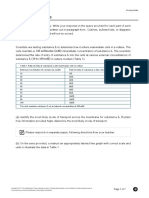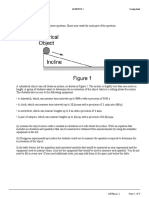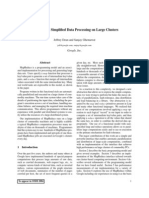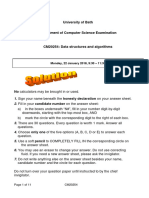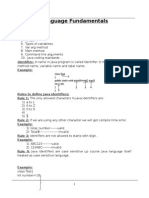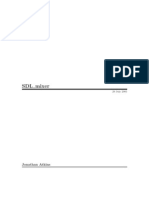SG Algorithms
SG Algorithms
Uploaded by
Amira AlwahshiCopyright:
Available Formats
SG Algorithms
SG Algorithms
Uploaded by
Amira AlwahshiOriginal Title
Copyright
Available Formats
Share this document
Did you find this document useful?
Is this content inappropriate?
Copyright:
Available Formats
SG Algorithms
SG Algorithms
Uploaded by
Amira AlwahshiCopyright:
Available Formats
AP COMPUTER SCIENCE PRINCIPLES Scoring Guide
Algorithms 01
1. Which of the following best explains the ability to solve problems algorithmically?
Any problem can be solved algorithmically, though some algorithmic solutions may require humans to
(A)
validate the results.
Any problem can be solved algorithmically, though some algorithmic solutions must be executed on
(B)
multiple devices in parallel.
Any problem can be solved algorithmically, though some algorithmic solutions require a very large
(C)
amount of data storage to execute.
(D) There exist some problems that cannot be solved algorithmically using any computer.
2. For which of the following situations would it be best to use a heuristic in order to find a solution that runs in a
reasonable amount of time?
(A) Appending a value to a list of elements, which requires no list elements be examined.
Finding the fastest route that visits every location among locations, which requires possible routes
(B)
be examined.
Performing a binary search for a score in a sorted list of scores, which requires that fewer than
(C)
scores be examined.
Performing a linear search for a name in an unsorted database of people, which requires that up to
(D)
entries be examined.
3. Three different numbers need to be placed in order from least to greatest. For example, if the numbers are ordered 9,
16, 4, they should be reordered as 4, 9, 16. Which of the following algorithms can be used to place any three
numbers in the correct order?
If the first number is greater than the last number, swap them. Then, if the first number is greater than
(A)
the middle number, swap them.
If the first number is greater than the middle number, swap them. Then, if the middle number is greater
(B)
than the last number, swap them.
If the first number is greater than the middle number, swap them. Then, if the middle number is greater
(C)
than the last number, swap them. Then, if the first number is greater than the last number, swap them.
If the first number is greater than the middle number, swap them. Then, if the middle number is greater
(D) than the last number, swap them. Then, if the first number is greater than the middle number, swap
them.
4. Under which of the following conditions is it most beneficial to use a heuristic approach to solve a problem?
(A) When the problem can be solved in a reasonable time and an approximate solution is acceptable
(B) When the problem can be solved in a reasonable time and an exact solution is needed
(C) When the problem cannot be solved in a reasonable time and an approximate solution is acceptable
(D) When the problem cannot be solved in a reasonable time and an exact solution is needed
AP Computer Science Principles Page 1 of 31
Scoring Guide
Algorithms 01
5. The figure below shows four grids, each containing a robot represented as a triangle. The robot cannot move to a
black square or move beyond the edge of the grid.
Which of the following algorithms will allow the robot to make a single circuit around the rectangular region of
black squares, finishing in the exact location and direction that it started in each of the four grids?
Page 2 of 31 AP Computer Science Principles
Scoring Guide
Algorithms 01
Step 1:
Keep moving forward, one square at a time, until the square to the right of the
robot is black.
(A)
Step 2:
Turn right and move one square forward.
Step 3:
Repeat steps 1 and 2 three more times.
Step 1:
Keep moving forward, one square at a time, until the square to the right of the
(B) robot is no longer black.
Step 2:
Turn right and move one square forward.
Step 3: Repeat steps 1 and 2 three more times.
Step 1:
Move forward three squares.
(C)
Step 2:
Turn right and move one square forward.
Step 3: If the square to the right of the robot is black, repeat steps 1 and 2.
Step 1:
Move forward three squares.
Step 2:
(D) Turn right and move one square forward.
Step 3:
If the square to the right of the robot is not black, repeat steps 1 and 2.
AP Computer Science Principles Page 3 of 31
Scoring Guide
Algorithms 01
6. The question below uses a robot in a grid of squares. The robot is represented as a triangle, which is initially in the
center square and facing toward the top of the grid.
The following code segment is used to move the robot in the grid.
count 1
REPEAT 4 TIMES
{
REPEAT count TIMES
{
MOVE_FORWARD()
}
ROTATE_LEFT()
count ← count + 1
}
Which of the following code segments will move the robot from the center square along the same path as the code
segment above?
Page 4 of 31 AP Computer Science Principles
Scoring Guide
Algorithms 01
count 0
REPEAT 4 TIMES
{
count ← count + 1
REPEAT count TIMES
(A) {
MOVE_FORWARD()
}
ROTATE_LEFT()
}
count 0
REPEAT 4 TIMES
{
count ← count + 1
ROTATE_LEFT()
(B) REPEAT count TIMES
{
MOVE_FORWARD()
}
}
count 0
REPEAT 4 TIMES
{
REPEAT count TIMES
{
(C) ROTATE_LEFT()
}
MOVE_FORWARD()
count ← count + 1
}
count 0
REPEAT 4 TIMES
{
ROTATE_LEFT()
REPEAT count TIMES
(D) {
MOVE_FORWARD()
}
count ← count + 1
}
AP Computer Science Principles Page 5 of 31
Scoring Guide
Algorithms 01
7. In the following code segment, assume that x and y have been assigned integer values.
sum 0
REPEAT x TIMES
{
REPEAT y TIMES
{
sum ← sum + 1
}
}
At the end of which of the following code segments is the value of sum the same as the value of sum at the end
of the preceding code segment?
Select two answers.
sum 0
z x + y
REPEAT z TIMES
(A) {
sum ← sum + 1
}
sum 0
z x * y
REPEAT z TIMES
(B) {
sum ← sum + 1
}
sum 0
REPEAT x TIMES
{
sum ← sum + 1
(C) }
REPEAT y TIMES
{
sum ← sum + 1
}
sum 0
REPEAT y TIMES
{
REPEAT x TIMES
(D) {
sum ← sum + 1
}
}
Page 6 of 31 AP Computer Science Principles
Scoring Guide
Algorithms 01
8. An online game collects data about each player’s performance in the game. A program is used to analyze the data to
make predictions about how players will perform in a new version of the game.
The procedure GetPrediction (idNum) returns a predicted score for the player with ID number idNum.
Assume that all predicted scores are positive. The GetPrediction procedure takes approximately 1 minute to
return a result. All other operations happen nearly instantaneously.
Two versions of the program are shown below.
Version I
topScore 0
idList [1298702, 1356846, 8848491, 8675309]
FOR EACH id IN idList
{
score ← GetPrediction (id)
IF (score > topScore)
{
topScore ← score
}
}
DISPLAY (topScore)
Version II
idList [1298702, 1356846, 8848491, 8675309]
topID idList[1]
FOR EACH id IN idList
{
IF (GetPrediction (id) > GetPrediction (topID))
{
topID ← id
}
}
DISPLAY (GetPrediction (topID))
Which of the following best compares the execution times of the two versions of the program?
(A) Version I requires approximately 1 more minute to execute than version II.
(B) Version I requires approximately 5 more minutes to execute than version II.
(C) Version II requires approximately 1 more minute to execute than version I.
(D) Version II requires approximately 5 more minutes to execute than version I.
AP Computer Science Principles Page 7 of 31
Scoring Guide
Algorithms 01
9. Consider the two programs below.
Which of the following best compares the values displayed by programs A and B?
(A) Program A and program B display identical values in the same order.
(B) Program A and program B display the same values in different orders.
(C) Program A and program B display the same number of values, but the values differ.
(D) Program B displays one more value than program A.
10. Directions: The question or incomplete statement below is followed by four suggested answers or
completions. Select the one that is best in each case.
Consider the code segment below.
Which of the following changes will NOT affect the results when the code segment is executed?
(A) Changing line 3 to
(B) Changing line 3 to
(C) Changing line 7 to
(D) Changing line 7 to
Page 8 of 31 AP Computer Science Principles
Scoring Guide
Algorithms 01
11. Directions: The question or incomplete statement below is followed by four suggested answers or
completions. Select the one that is best in each case.
The two code segments below are each intended to display the average of the numbers in the list
. Assume that contains more than one value.
Which of the following best describes the two code segments?
(A) Code segment I displays the correct average, but code segment II does not.
(B) Code segment II displays the correct average, but code segment I does not.
Both code segments display the correct average, but code segment I requires more arithmetic operations
(C)
than code segment II.
Both code segments display the correct average, but code segment II requires more arithmetic operations
(D)
than code segment I.
AP Computer Science Principles Page 9 of 31
Scoring Guide
Algorithms 01
12. Directions: The question or incomplete statement below is followed by four suggested answers or
completions. Select the one that is best in each case.
Consider the two programs below.
Which of the following best compares the values displayed by programs A and B?
(A) Program A and program B display identical values.
(B) Program A and program B display the same values in different orders.
(C) Program A and program B display the same number of values, but the values differ.
(D) Program A and program B display a different number of values.
Page 10 of 31 AP Computer Science Principles
Scoring Guide
Algorithms 01
13. Directions: The question or incomplete statement below is followed by four suggested answers or
completions. Select the one that is best in each case.
The question below uses a robot in a grid of squares. The robot is represented as a triangle, which is initially in the
bottom right square of the grid and facing toward the top of the grid.
The following programs are each intended to move the robot to the gray square. Program II uses the procedure
, which returns if the robot is in the gray square and returns
otherwise.
Which of the following statements is true?
(A) Program I correctly moves the robot to the gray square, but program II does not.
(B) Program II correctly moves the robot to the gray square, but program I does not.
(C) Both program I and program II correctly move the robot to the gray square.
(D) Neither program I nor program II correctly moves the robot to the gray square.
AP Computer Science Principles Page 11 of 31
Scoring Guide
Algorithms 01
14. Programs I and II below are each intended to calculate the sum of the integers from 1 to n. Assume that n is a
positive integer (e.g., 1, 2, 3, …).
Which of the following best describes the behavior of the two programs?
(A) Program I displays the correct sum, but program II does not.
(B) Program II displays the correct sum, but program I does not.
(C) Both program I and program II display the correct sum.
(D) Neither program I nor program II displays the correct sum.
15. A team of programmers is designing software. One portion of the project presents a problem for which there is not
an obvious solution. After some research, the team determines that the problem is undecidable. Which of the
following best explains the consequence of the problem being undecidable?
(A) The problem can be solved algorithmically, but it will require an unreasonably long amount of time.
The problem can be solved algorithmically, but it will require an unreasonably large amount of data
(B)
storage.
(C) There is no possible algorithm that can be used to solve all instances of the problem.
There are several different possible algorithms that can solve the problem, but there is controversy about
(D)
which is the most efficient.
16. A certain computer game is played between a human player and a computer-controlled player. Every time the
computer-controlled player has a turn, the game runs slowly because the computer evaluates all potential moves and
selects the best one. Which of the following best describes the possibility of improving the running speed of the
game?
Page 12 of 31 AP Computer Science Principles
Scoring Guide
Algorithms 01
The game’s running speed can only be improved if the game is played between two human players
(A)
instead of with the computer-controlled player.
The game’s running speed might be improved by using a process that finds approximate solutions every
(B)
time the computer-controlled player has a turn.
The game’s running speed cannot be improved because computers can only be programmed to find the
(C)
best possible solution.
The game’s running speed cannot be improved because the game is an example of an algorithm that
(D)
does not run in a reasonable time.
17. A computer scientist is analyzing four different algorithms used to sort a list. The table below shows the number of
steps each algorithm took to sort lists of different sizes.
Number of Steps Number of Steps Number of Steps Number of Steps
List Size
for Algorithm A for Algorithm B for Algorithm C for Algorithm D
1 10 2 1 1
2 20 4 2 4
3 30 8 6 9
4 40 16 24 16
5 50 32 120 25
Based on the values in the table, which of the algorithms appear to run in reasonable time?
Select two answers.
(A) Algorithm A
(B) Algorithm B
(C) Algorithm C
(D) Algorithm D
AP Computer Science Principles Page 13 of 31
Scoring Guide
Algorithms 01
18. Directions: The question or incomplete statement below is followed by four suggested answers or
completions. Select the one that is best in each case.
A video-streaming service maintains a database of information about its customers and the videos they have
watched.
The program below analyzes the data in the database and compares the number of viewers of science fiction videos
to the number of viewers of videos of other genres. It uses the procedure , which
returns the number of unique users who viewed videos of a given category in the past year. The
procedure takes approximately 1 hour to return a result, regardless of the number of videos of the given genre. All
other operations happen nearly instantaneously.
Which of the following best approximates the amount of time it takes the program to execute?
(A) 1 hour
(B) 2 hours
(C) 4 hours
(D) 5 hours
19. In the following statement, val1, val2, and result are Boolean variables.
Which of the following code segments produce the same result as the statement above for all possible values of
val1 and val2 ?
Select two answers.
Page 14 of 31 AP Computer Science Principles
Scoring Guide
Algorithms 01
(A)
(B)
(C)
(D)
AP Computer Science Principles Page 15 of 31
Scoring Guide
Algorithms 01
20. Directions: The question or incomplete statement below is followed by four suggested answers or
completions. Select the one that is best in each case.
An online retailer uses an algorithm to sort a list of n items by price. The table below shows the approximate
number of steps the algorithm takes to sort lists of different sizes.
Based on the values in the table, which of the following best characterizes the algorithm for very large values of n ?
(A) The algorithm runs in reasonable time.
(B) The algorithm runs, but not in reasonable time.
(C) The algorithm attempts to solve an undecidable problem.
(D) The algorithm attempts to find an approximate solution whenever it fails to find an exact solution.
Page 16 of 31 AP Computer Science Principles
Scoring Guide
Algorithms 01
21. A programmer wrote the code segment below to display the average of all the elements in a list called numbers.
There is always at least one number in the list.
The programmer wants to reduce the number of operations that are performed when the program is run. Which
change will result in a correct program with a reduced number of operations performed?
(A) Interchanging line 1 and line 2
(B) Interchanging line 5 and line 6
(C) Interchanging line 6 and line 7
(D) Interchanging line 7 and line 8
22. Consider the following algorithms. Each algorithm operates on a list containing n elements, where n is a very large
integer.
I. An algorithm that accesses each element in the list twice
II. An algorithm that accesses each element in the list n times
III. An algorithm that accesses only the first 10 elements in the list, regardless of the size of the list
Which of the algorithms run in reasonable time?
(A) I only
(B) III only
(C) I and II only
(D) I, II, and III
23. Which of the following statements is true?
AP Computer Science Principles Page 17 of 31
Scoring Guide
Algorithms 01
Every problem can be solved with an algorithm for all possible inputs, in a reasonable amount of time,
(A)
using a modern computer.
Every problem can be solved with an algorithm for all possible inputs, but some will take more than 100
(B)
years, even with the fastest possible computer.
Every problem can be solved with an algorithm for all possible inputs, but some of these algorithms
(C)
have not been discovered yet.
(D) There exist problems that no algorithm will ever be able to solve for all possible inputs.
Page 18 of 31 AP Computer Science Principles
Scoring Guide
Algorithms 01
24. The question below uses a robot in a grid of squares. The robot is represented as a triangle, which is initially in the
bottom left square of the grid and facing right.
The following programs are each intended to move the robot to the gray square. Program II uses the procedure
GoalReached, which returns true if the robot is in the gray square and returns false otherwise.
AP Computer Science Principles Page 19 of 31
Scoring Guide
Algorithms 01
Which of the following statements best describes the correctness of the programs?
(A) Program I correctly moves the robot to the gray square, but program II does not.
(B) Program II correctly moves the robot to the gray square, but program I does not.
(C) Both program I and program II correctly move the robot to the gray square.
(D) Neither program I nor program II correctly moves the robot to the gray square.
25. A student wants to determine whether a certain problem is undecidable. Which of the following will demonstrate
that the problem is undecidable?
Show that for one instance of the problem, an algorithm can be written that is always capable of
(A)
providing a correct yes-or-no answer.
Show that for one instance of the problem, no algorithm can be written that is capable of providing a
(B)
correct yes-or-no answer.
Show that for one instance of the problem, a heuristic is needed to write an algorithm that is capable of
(C)
providing a correct yes-or-no answer.
Show that for one instance of the problem, an algorithm that runs in unreasonable time can be written
(D)
that is capable of providing a correct yes-or-no answer.
26. A graphic artist uses a program to draw geometric shapes in a given pattern. The program uses an algorithm that
draws the shapes based on input from the artist. The table shows the approximate number of steps the algorithm
takes to draw different numbers of shapes.
Number of Number of
Shapes Drawn Steps
4 17
5 24
6 35
7 50
Based on the values in the table, which of the following best characterizes the algorithm for drawing shapes,
where is a very large number?
Page 20 of 31 AP Computer Science Principles
Scoring Guide
Algorithms 01
The algorithm runs in a reasonable amount of time because it will use approximately steps to draw
(A)
shapes.
The algorithm runs in a reasonable amount of time because it will use approximately steps to draw
(B)
shapes.
The algorithm runs in an unreasonable amount of time because it will use approximately steps to draw
(C)
shapes.
The algorithm runs in an unreasonable amount of time because it will use approximately steps to
(D)
draw shapes.
27. A company delivers packages by truck and would like to minimize the length of the route that each driver must
travel in order to reach delivery locations. The company is considering two different algorithms for determining
delivery routes.
Algorithm I Generate all possible routes, compute their lengths, and then select the shortest possible
route. This algorithm does not run in reasonable time.
Algorithm II Starting from an arbitrary delivery location, find the nearest unvisited delivery location.
Continue creating the route by selecting the nearest unvisited location until all locations
have been visited. This algorithm does not guarantee the shortest possible route and runs
in time proportional to .
Which of the following best categorizes algorithm II?
(A) Algorithm II attempts to use an algorithmic approach to solve an otherwise undecidable problem.
(B) Algorithm II uses a heuristic approach to provide an approximate solution in reasonable time.
Algorithm II provides no improvement over algorithm I because neither algorithm runs in reasonable
(C)
time.
(D) Algorithm II requires a much faster computer in order to provide any improvement over algorithm I.
AP Computer Science Principles Page 21 of 31
Scoring Guide
Algorithms 01
28. A flowchart is a way to visually represent an algorithm. The flowchart below is used by an application to set the
Boolean variable available to true under certain conditions. The flowchart uses the Boolean variable
weekday and the integer variable miles.
Block Explanation
Oval The start or end of the algorithm
A conditional or decision step, where execution proceeds to the side labeled true if the
Diamond
condition is true and to the side labeled false otherwise
Rectangle One or more processing steps, such as a statement that assigns a value to a variable
Which of the following statements is equivalent to the algorithm in the flowchart?
Page 22 of 31 AP Computer Science Principles
Scoring Guide
Algorithms 01
(A)
(B)
(C)
(D)
29. Which of the following best explains how algorithms that run on a computer can be used to solve problems?
(A) All problems can be solved with an algorithm that runs in a reasonable amount of time.
All problems can be solved with an algorithm, but some algorithms might need a heuristic to run in a
(B)
reasonable amount of time.
All problems can be solved with an algorithm, but some algorithms might run in an unreasonable
(C)
amount of time.
(D) Some problems cannot be solved by an algorithm.
30. Consider the following code segment with an integer variable num.
IF(num > 0)
{
DISPLAY("positive")
}
IF(num < 0)
{
DISPLAY("negative")
}
IF(num = 0)
{
DISPLAY("zero")
}
Which of the following code segments is equivalent to the code segment above?
AP Computer Science Principles Page 23 of 31
Scoring Guide
Algorithms 01
IF(num < 0)
{
DISPLAY("negative")
}
ELSE
{
(A) DISPLAY("positive")
}
IF(num = 0)
{
DISPLAY("zero")
}
IF(num < 0)
{
DISPLAY("negative")
}
ELSE
{
IF(num = 0)
(B) {
DISPLAY("zero")
}
ELSE
{
DISPLAY("positive")
}
}
IF(num ≤ 0)
{
DISPLAY("negative")
}
ELSE
{
IF(num = 0)
(C) {
DISPLAY("zero")
}
ELSE
{
DISPLAY("positive")
}
}
IF(num ≤ 0)
{
DISPLAY("negative")
}
IF(num = 0)
{
(D) DISPLAY("zero")
}
ELSE
{
DISPLAY("positive")
}
Page 24 of 31 AP Computer Science Principles
Scoring Guide
Algorithms 01
31. Which of the following best explains why it is not possible to use computers to solve every problem?
(A) Current computer processing capabilities cannot improve significantly.
Large-scale problems require a crowdsourcing model, which is limited by the number of people
(B)
available to work on the problem.
The ability of a computer to solve a problem is limited by the bandwidth of the computer’s Internet
(C)
connection.
(D) There exist some problems that cannot be solved using any algorithm.
32. Directions: The question or incomplete statement below is followed by four suggested answers or
completions. Select the one that is best in each case.
A student wants to create an algorithm that can determine, given any program and program input, whether or not the
program will go into an infinite loop for that input.
The problem the student is attempting to solve is considered an undecidable problem. Which of the following is
true?
It is possible to create an algorithm that will solve the problem for all programs and inputs, but the
(A)
algorithm can only be implemented in a low-level programming language.
It is possible to create an algorithm that will solve the problem for all programs and inputs, but the
(B)
algorithm requires simultaneous execution on multiple CPUs.
It is possible to create an algorithm that will solve the problem for all programs and inputs, but the
(C)
algorithm will not run in reasonable time.
(D) It is not possible to create an algorithm that will solve the problem for all programs and inputs.
AP Computer Science Principles Page 25 of 31
Scoring Guide
Algorithms 01
33. The following grid contains a robot represented as a triangle, which is initially in the bottom-left square of the grid
and facing the top of the grid. The robot can move into a white or a gray square but cannot move into a black
region.
The following code segment implements an algorithm that moves the robot from its initial position to the gray
square and facing the top of the grid.
Page 26 of 31 AP Computer Science Principles
Scoring Guide
Algorithms 01
When the robot reaches the gray square, it turns around and faces the bottom of the grid. Which of the following
changes, if any, should be made to the code segment to move the robot back to its original position in the bottom-
left square of the grid and facing toward the bottom of the grid?
(A) Interchange the ROTATE_RIGHT and the ROTATE_LEFT blocks.
(B) Replace ROTATE_RIGHT with ROTATE_LEFT.
(C) Replace ROTATE_LEFT with ROTATE_RIGHT.
(D) No change is needed; the algorithm is correct as is.
AP Computer Science Principles Page 27 of 31
Scoring Guide
Algorithms 01
34. Consider the following program.
Which of the following expressions represents the value stored in the variable x as a result of executing the
program?
(A) 2 * 3 * 3 * 3
(B) 2 * 4 * 4 * 4
(C) 2 * 3 * 3 * 3 * 3
(D) 2 * 4 * 4 * 4 * 4
Page 28 of 31 AP Computer Science Principles
Scoring Guide
Algorithms 01
35. Directions: The question or incomplete statement below is followed by four suggested answers or
completions. Select the one that is best in each case.
A student is creating a procedure to determine whether the weather for a particular month was considered very hot.
The procedure takes as input a list containing daily high temperatures for a particular month. The procedure is
intended to return if the daily high temperature was at least 90 degrees for a majority of days in the month
and return otherwise.
Which of the following can be used to replace so that the procedure works as intended?
(A)
(B)
(C)
(D)
AP Computer Science Principles Page 29 of 31
Scoring Guide
Algorithms 01
36. The following question uses a robot in a grid of squares. The robot is represented as a triangle, which is initially
facing toward the top of the grid.
The following code segment moves the robot around the grid. Assume that n is a positive integer.
Line 1: count 0
Line 2: REPEAT n TIMES
Line 3: {
Line 4: REPEAT 2 TIMES
Line 5: {
Line 6: MOVE_FORWARD()
Line 7: }
Line 8: ROTATE_RIGHT()
Line 9: }
Consider the goal of modifying the code segment to count the number of squares the robot visits before execution
terminates. Which of the following modifications can be made to the code segment to correctly count the number of
squares the robot moves to?
Page 30 of 31 AP Computer Science Principles
Scoring Guide
Algorithms 01
(A) Inserting the statement count count + 1 between line 6 and line 7
(B) Inserting the statement count count + 2 between line 6 and line 7
(C) Inserting the statement count count + 1 between line 8 and line 9
(D) Inserting the statement count count + n between line 8 and line 9
37. Which of the following programs is most likely to benefit from the use of a heuristic?
(A) A program that calculates a student’s grade based on the student’s quiz and homework scores
(B) A program that encrypts a folder of digital files
(C) A program that finds the shortest driving route between two locations on a map
(D) A program that sorts a list of numbers in order from least to greatest
AP Computer Science Principles Page 31 of 31
You might also like
- Ap Computer Science Principles Practice Exam and Notes 2021Document108 pagesAp Computer Science Principles Practice Exam and Notes 2021Joseph Petersen100% (3)
- AP 2020 Physics Exam - Step 3 - Question 2Document5 pagesAP 2020 Physics Exam - Step 3 - Question 2Alex0% (1)
- Ap Computer Science Principles Test BookletDocument43 pagesAp Computer Science Principles Test BookletWaheetha Banu100% (1)
- T4 MC Annotated KeyDocument23 pagesT4 MC Annotated KeyVineeth SendilrajNo ratings yet
- Mock 2 PracticeDocument78 pagesMock 2 PracticeAmira AlwahshiNo ratings yet
- T1-Mock Answers 2Document48 pagesT1-Mock Answers 2Amira AlwahshiNo ratings yet
- AP Calculus AB Practice Exam and Answers PDFDocument46 pagesAP Calculus AB Practice Exam and Answers PDFKousuke YasumuraNo ratings yet
- Quiz Apcspracticemultiplechoicetest2016Document31 pagesQuiz Apcspracticemultiplechoicetest2016api-255636511100% (1)
- How To Use SIC Simulator and AssemblerDocument12 pagesHow To Use SIC Simulator and AssemblerMena SamehNo ratings yet
- HTML & JavaScript - Practice Questions PDFDocument103 pagesHTML & JavaScript - Practice Questions PDFpurerosero100% (2)
- Unit 1 AP Computer Science Practice Exam - NewDocument4 pagesUnit 1 AP Computer Science Practice Exam - NewHishamNo ratings yet
- APCS MCQ葵花宝Document67 pagesAPCS MCQ葵花宝xinpei zhouNo ratings yet
- 2022 AP Computer Science Principles Student SamplesDocument39 pages2022 AP Computer Science Principles Student SamplesMohamed AliNo ratings yet
- TB LoopsandConditionalsPracticeTestDocument34 pagesTB LoopsandConditionalsPracticeTestemi dNo ratings yet
- AP Practice ExamDocument18 pagesAP Practice ExamDSaulBNo ratings yet
- 预备微积分2024参考试卷#3 学生Document52 pages预备微积分2024参考试卷#3 学生hqy1993goodNo ratings yet
- FRQ 2 Sample With KeyDocument5 pagesFRQ 2 Sample With KeyDestiny SumaniNo ratings yet
- TB 111 65475e0e903cd6.65475e1023ddf5.26934364Document3 pagesTB 111 65475e0e903cd6.65475e1023ddf5.26934364zjyblksNo ratings yet
- 预备微积分2024参考试卷#2 学生Document51 pages预备微积分2024参考试卷#2 学生hqy1993goodNo ratings yet
- BC Mock 7 (2017 PT)Document52 pagesBC Mock 7 (2017 PT)TiênNo ratings yet
- AP Precalculus Unit2aDocument20 pagesAP Precalculus Unit2a19Tamal ChatterjeeNo ratings yet
- Broward County Schools AP Physics 1 ReviewDocument20 pagesBroward County Schools AP Physics 1 Reviewchris hemmainNo ratings yet
- Digital SAT - Answer KeyDocument8 pagesDigital SAT - Answer KeyRico YupitaNo ratings yet
- 1.1 MCQ+FRQ: Ap Calculus BC Scoring GuideDocument11 pages1.1 MCQ+FRQ: Ap Calculus BC Scoring Guidebl2ckiceNo ratings yet
- Ap Computer Science Principles Explore Performance Task Curricular RequirementDocument52 pagesAp Computer Science Principles Explore Performance Task Curricular RequirementJoseph PetersenNo ratings yet
- SG Unit2progresscheckfrq 5e815f7aa64825Document7 pagesSG Unit2progresscheckfrq 5e815f7aa64825api-485795043No ratings yet
- APCSP Written ResponsesDocument4 pagesAPCSP Written ResponsesNaomi Hammonds [STUDENT]No ratings yet
- Aplang 2007 Answer KeyDocument3 pagesAplang 2007 Answer KeyJorge LopezNo ratings yet
- 1.4 TB - EstimatingLimitValuesfromTablesQuiz - 628c95a8255554.628c95aaa0add4.78852521Document4 pages1.4 TB - EstimatingLimitValuesfromTablesQuiz - 628c95a8255554.628c95aaa0add4.78852521Hassan Ehsaiyan SaqerNo ratings yet
- TB 113 65475f28681943.65475f29de8093.92261726Document5 pagesTB 113 65475f28681943.65475f29de8093.92261726zjyblksNo ratings yet
- AP Calc Exam 1Document10 pagesAP Calc Exam 1Jordan MilesNo ratings yet
- Ap21 Apc Computer Science A q4Document15 pagesAp21 Apc Computer Science A q4hlloNo ratings yet
- Unit 4 AP Computer Science Practice Exam NewDocument9 pagesUnit 4 AP Computer Science Practice Exam Newzavage4No ratings yet
- APHG Test Review: Included: ScheduleDocument3 pagesAPHG Test Review: Included: ScheduleShadowNo ratings yet
- SG Unit1ProgressCheckFRQ 639bd51a131ff4.639bd51b6e3532.89528732Document9 pagesSG Unit1ProgressCheckFRQ 639bd51a131ff4.639bd51b6e3532.89528732Dr. JOEJONo ratings yet
- Practice Exam 1Document32 pagesPractice Exam 1Jeremy KingNo ratings yet
- 8.6 Finding The Area Between Curves That Intersect at More Than Two PointsDocument6 pages8.6 Finding The Area Between Curves That Intersect at More Than Two Pointsjan wangNo ratings yet
- AP CSA FRQ PracticeDocument11 pagesAP CSA FRQ Practicebeanwizard2006No ratings yet
- Acsl 16-17 Contest 3 Notes - Boolean Data Structures Regex Prev Boolean Graph Theory Bit StringDocument40 pagesAcsl 16-17 Contest 3 Notes - Boolean Data Structures Regex Prev Boolean Graph Theory Bit Stringapi-328824013No ratings yet
- MapReduce: Simplified Data Processing On Large ClustersDocument13 pagesMapReduce: Simplified Data Processing On Large Clusterszzztimbo100% (1)
- Aphg Final Exam Review by Sarah HandlerDocument35 pagesAphg Final Exam Review by Sarah HandlerbrandonNo ratings yet
- BC Practice Test 3Document7 pagesBC Practice Test 3Tim JonesNo ratings yet
- AP Physics 1 - Torque QuestionsDocument23 pagesAP Physics 1 - Torque QuestionsMiaNo ratings yet
- 01 Kinematics MCQDocument23 pages01 Kinematics MCQCharlie kimNo ratings yet
- 25 Questions: Section 4Document8 pages25 Questions: Section 4gzboyzoneNo ratings yet
- Ap Computer Science A SlidesDocument20 pagesAp Computer Science A Slidesapi-644507461No ratings yet
- Practice Exam QuestionsDocument12 pagesPractice Exam QuestionsAnsh ChaudharyNo ratings yet
- AP Physics 1 Practice Exam #2 For The 2022 ExamDocument140 pagesAP Physics 1 Practice Exam #2 For The 2022 ExamliubingveraNo ratings yet
- AP Calc Midterm (MCQ Part 2-Calc) 2021Document6 pagesAP Calc Midterm (MCQ Part 2-Calc) 2021Farhana Sabrin0% (1)
- TB 110 65475dd6d4e409.65475dd816cef6.68238885Document2 pagesTB 110 65475dd6d4e409.65475dd816cef6.68238885zjyblksNo ratings yet
- AP Computer Science A Exam ReviewDocument110 pagesAP Computer Science A Exam ReviewPamela Smith100% (1)
- TB 17 65475b1fe9a0c3.65475b2172cf01.34694443Document2 pagesTB 17 65475b1fe9a0c3.65475b2172cf01.34694443zjyblksNo ratings yet
- Practice MCQ Unit 1Document59 pagesPractice MCQ Unit 18s5nb5pk8bNo ratings yet
- Apush 2018 PleaseaDocument112 pagesApush 2018 Pleaseakadenpizza66No ratings yet
- AP Calculus BC Practice TestDocument18 pagesAP Calculus BC Practice TestAnanyaNo ratings yet
- ACT Math Section and SAT Math Level 2 Subject Test Practice Problems 2013 EditionFrom EverandACT Math Section and SAT Math Level 2 Subject Test Practice Problems 2013 EditionRating: 3 out of 5 stars3/5 (3)
- Hcic 2021Document20 pagesHcic 2021wuzhixianNo ratings yet
- 2024S IP QuestionsDocument40 pages2024S IP QuestionshninNo ratings yet
- Directions For Questions 1 To 30: Select The Correct AlternaDocument4 pagesDirections For Questions 1 To 30: Select The Correct AlternaAKASH PALNo ratings yet
- Melect 2: Algebra and TrigonometryDocument64 pagesMelect 2: Algebra and TrigonometryLordesNo ratings yet
- CM20254 Exam 2017 SolutionDocument11 pagesCM20254 Exam 2017 SolutionYufan YeNo ratings yet
- Resource 20230216201018 G11 Computer Sci. (Exam Capsule)Document7 pagesResource 20230216201018 G11 Computer Sci. (Exam Capsule)Sasidaran SasiNo ratings yet
- NZ Load Examples PDFDocument11 pagesNZ Load Examples PDFsramkumar88No ratings yet
- Cs 237 - Object Oriented Programming Anna UniversityDocument40 pagesCs 237 - Object Oriented Programming Anna UniversitypalanisaamyNo ratings yet
- 1.strating Classes (20 Files Merged)Document743 pages1.strating Classes (20 Files Merged)Nagesh ReddyNo ratings yet
- Cs PDFDocument49 pagesCs PDFTHANIGAINATHAN.G.D 10A3No ratings yet
- COPA 2ndsemQBJDocument28 pagesCOPA 2ndsemQBJsoni kumar bhardwajNo ratings yet
- Core Java BookDocument464 pagesCore Java Bookmallikarjun199No ratings yet
- AJAX - Asynchronous Java Script and XMLDocument4 pagesAJAX - Asynchronous Java Script and XMLpravin BalbudheNo ratings yet
- Tybca Slips-25marksDocument44 pagesTybca Slips-25marksapi-44627200050% (2)
- UNIT-III Inheritance, Interfaces, Packages and Exception HandlingDocument63 pagesUNIT-III Inheritance, Interfaces, Packages and Exception Handlingdil rockNo ratings yet
- ConstructorsDocument7 pagesConstructorshridanshutagotraNo ratings yet
- Unzipper - Unzipper - PHP at Master Ndeet - Unzipper GitHubDocument9 pagesUnzipper - Unzipper - PHP at Master Ndeet - Unzipper GitHubkhalifa1544No ratings yet
- C Program FinalDocument15 pagesC Program Finalindhumathi sNo ratings yet
- Bit WiseDocument24 pagesBit WiseSrijit Bose100% (1)
- ListingsDocument67 pagesListingsMaximo Torrez HuanacuNo ratings yet
- Operating System MCQDocument25 pagesOperating System MCQlakshmi.sNo ratings yet
- Memory Leaks in Java Applications: Different Tools For Different Types of Leaks Gregg Sporar Sun Microsystems, IncDocument53 pagesMemory Leaks in Java Applications: Different Tools For Different Types of Leaks Gregg Sporar Sun Microsystems, IncSrinivasa GowdaNo ratings yet
- He Following Questions Are Important Before Doing The HANA-SizingDocument16 pagesHe Following Questions Are Important Before Doing The HANA-Sizinggenemail28No ratings yet
- Welcome in AsDocument84 pagesWelcome in AsFlashPTNo ratings yet
- SDL MixerDocument94 pagesSDL MixerArkadiusz KarkoszkaNo ratings yet
- Argos Tech TrackDocument27 pagesArgos Tech TrackdesignwebargentinaNo ratings yet
- Matrix Chain MultiplicationDocument20 pagesMatrix Chain MultiplicationHarsh Tibrewal100% (1)
- Model Based Design PresentationDocument20 pagesModel Based Design PresentationKrishna KumarNo ratings yet
- Engineering Design Optimization: The Golden Section Algorithm The Golden Section AlgorithmDocument6 pagesEngineering Design Optimization: The Golden Section Algorithm The Golden Section Algorithmteknikpembakaran2013No ratings yet
- Snake & Ladder SOURCEDocument58 pagesSnake & Ladder SOURCEN JainNo ratings yet
- Apache Ofbiz: Real-World Open Source Java Platform Erp: Ean SchuesslerDocument25 pagesApache Ofbiz: Real-World Open Source Java Platform Erp: Ean SchuesslerrameasyNo ratings yet
- Principles of Training Multi-Layer Neural Network Using BackpropagationDocument9 pagesPrinciples of Training Multi-Layer Neural Network Using BackpropagationJustin PuscasuNo ratings yet
- Part 05 - Object Oriented ProgrammingDocument155 pagesPart 05 - Object Oriented ProgrammingJa KhangNo ratings yet
- Advanced C++ For Computational Finance: Daniel J. Duffy PresentsDocument6 pagesAdvanced C++ For Computational Finance: Daniel J. Duffy PresentsFilouNo ratings yet

























